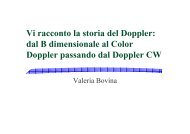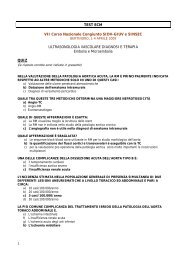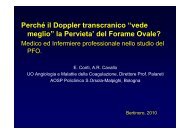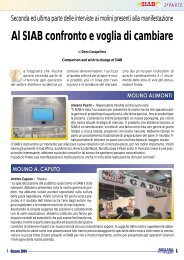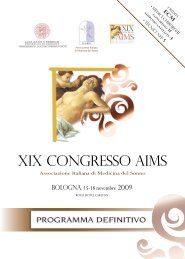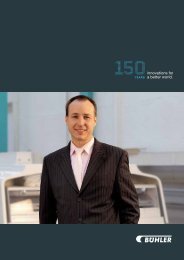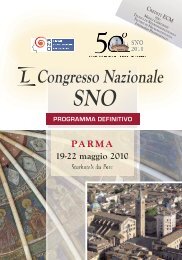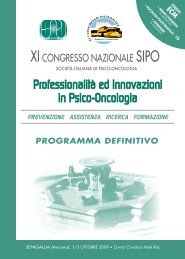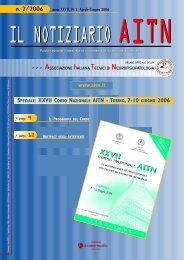MERCOLEDI' 5 OTTOBRE SALA C ORE 9 - Avenue media
MERCOLEDI' 5 OTTOBRE SALA C ORE 9 - Avenue media
MERCOLEDI' 5 OTTOBRE SALA C ORE 9 - Avenue media
You also want an ePaper? Increase the reach of your titles
YUMPU automatically turns print PDFs into web optimized ePapers that Google loves.
MODALITÀ IN CUI SONNO E PRIVAZIONE DI SONNO MODULANO LA REATTIVITÀ<br />
CORTICALE E I SUOI EFFETTI SULL‟EPILESSIA MIOCLONICA GIOVANILE: UNO<br />
STUDIO COMBINATO EEG – TMS.<br />
A Del Felice a , S Savazzi b , LG Bongiovanni a , A Fiaschi a , P Manganotti a<br />
a Dip . di Scienze neurologiche , neuropsichiatriche, morfologiche e motorie ,<br />
sezione Neurologia , Università di Verona<br />
b Dip . di Scienze neurologiche , neuropsichiatriche, morfologiche e motorie ,<br />
sezione Psicologia , Università di Verona<br />
OBJECTIVE: Simultaneous EEG-TMS permits to investigate cortical reactivity to external<br />
perturbations. TMS evoked potentials (TEPs) are described in normals during sleep (S)<br />
and wake (W) but neither after sleep deprivation (SD) nor in the frame of pathologically<br />
enhanced excitability – i.e. epilepsy. The aim of our study is to identify TEPs and their<br />
modifications during W, SD and S in normals and in juvenile myoclonic epileptics using<br />
EEG-TMS coregistration. MATERIALS AND METHODS: Focal TMS was delivered to the<br />
left primary motor cortex at 110% of motor threshold in 12 controls and 10 epileptics.<br />
Patients mantained therpeutic regimen throughout the study. TMS was delivered randomly<br />
8-15 sec during W, SD and S. At least 150 stimuli were recorded for each condition. EEG<br />
was simultaneously acquired from 32 scalp electrodes with the Brain Vision Recorder<br />
system. RESULTS: TMS induced a reproducible sequence of deflections on EEG. An<br />
amplitude’s statistically significant difference between states was observed for the late<br />
peaks (P100 and N190). In normals, after SD P100 amplitude showed a globally<br />
distributed increase, while N190 slighlty augmented over the posterior ares. In patients,<br />
both after SD and during S, ampiltude enhancement was evident for the P100 and N190<br />
peak over the antero-central derivations. Comparing the two groups, epileptics showed<br />
overall higher amplitude potentials, with P100 more evident over the posterior areas in S2,<br />
and N190 more represented anteriorly in S2 and centrally during SD. DISCUSSION: We<br />
demonstre an overll higher cortical excitability in epileptics. Moreover, the same group<br />
showed an amplitude increase of TEPs over the anterior areas after sleep deprivation and<br />
during rebound sleep.This phenomenon could relate to the disfunction of the<br />
corticothalamic circuit supposed to cause myoclonic epilepsy and the higher susceptibility<br />
to the effects of sleep deprivation of frontal and prefrontal areas. CONCLUSION: sleep<br />
deprivation is an effective enhacer of cortical excitability, expecially in the epileptic,<br />
pathologically hyperexcitable, brain<br />
5



